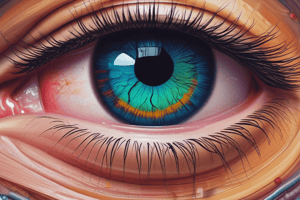Podcast
Questions and Answers
What is visual field testing used for?
What is visual field testing used for?
Pathological evaluations of the eye, especially retinal conditions.
What is an apostilb?
What is an apostilb?
- An absolute unit of luminance (correct)
- A type of eye condition
- A relative unit of luminance
- A factor of visual field sensitivity
Which of the following strategies is NOT a visual field testing strategy?
Which of the following strategies is NOT a visual field testing strategy?
- Screening strategy
- FAST Threshold strategy
- Full Threshold strategy
- Random testing strategy (correct)
What is the difference between the 30 and 24 degrees tests?
What is the difference between the 30 and 24 degrees tests?
What does a zero decibel (0 dB) represent in visual field testing?
What does a zero decibel (0 dB) represent in visual field testing?
In the 4-2 staircase method, the stimulus intensity is increased in ______ steps.
In the 4-2 staircase method, the stimulus intensity is increased in ______ steps.
The FAST Threshold Strategies use high stimuli at central fields.
The FAST Threshold Strategies use high stimuli at central fields.
What is the purpose of the WANDER scheme in visual field report interpretation?
What is the purpose of the WANDER scheme in visual field report interpretation?
Flashcards are hidden until you start studying
Study Notes
Visual Field Testing
- Visual field testing is crucial for diagnosing eye pathologies, particularly retinal conditions.
- Accurate visual field interpretation can reveal significant insights into eye health.
- Knowledge in optometry is equated with sight; understanding visual fields enhances patient care.
Apostilbs and Decibels
- Luminance of test targets measured in apostilbs, an absolute unit of luminance.
- Decibels create a relative scale for sensitivity in visual field testing, not standardized across devices.
- Brightest stimulus correlates to 0 dB; dimmest stimulus varies between devices (40 dB for Octopus, 50 dB for Humphrey).
Reading Visual Field Reports: WANDER Scheme
- WANDER provides a systematic approach to interpreting visual field printouts, particularly for Humphrey tests.
- WANDER Steps:
- WHAT WAS DONE?: Check test area and strategy used.
Test Area Specifications
- Various test areas include:
- 60 degrees: Broad field of vision.
- 30 degrees: Standard peripheral testing.
- 24 degrees: Similar to 30 degrees with fewer peripheral points.
- 10 degrees: Focused on central vision; ideal for macular problems and advanced glaucoma.
- In a 24-degree test, fewer peripheral rings are tested than in 30 degrees; specifically retains nasal rings due to glaucoma relevance.
Testing Strategies
- Full Threshold Strategy: Involves presenting multiple stimuli at the same point using a staircase method (4-2 dB). Reliable but time-consuming.
- Fast Threshold Strategies: Utilize models of normal and abnormal visual fields, adjusting stimulus intensity based on region sensitivity.
- Strategies include SITA and TOP methods, as well as screening methods like 2 or 3 zone screening.
Full Threshold Strategy Details
- Utilizes a staircasing technique to determine differential light thresholds at every visual field point.
- The Humphrey perimeter records the last seen stimulus as the threshold.
Fast Threshold Strategy Overview
- Assumes higher sensitivity at the central visual fields; implements lower threshold stimuli where vision is normally acute and higher thresholds in peripheral areas where sensitivity diminishes.
Studying That Suits You
Use AI to generate personalized quizzes and flashcards to suit your learning preferences.




